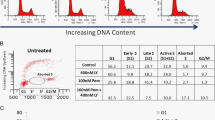Summary
BMY-40481-30 is a new, water-soluble derivative and probable prodrug of etoposide characterized by the presence of a phosphate group in position 4′ of the E ring of the etoposide molecule. The compound was only weakly cytotoxic in vitro and, consequently, an investigation of its antitumor activity was conducted in several murine and human tumor (xenograft) models. Etoposide was administered ip or po whereas BMY-40481-30 was given ip, po or iv. The potency of the derivative, when administered parenterally, as defined on the basis of maximum tolerated dose (MTD), was less than the parent compound on a weight (mg/kg) basis in some experiments but comparable to etoposide in other instances. Comparison at the MTD of the two compounds showed that BMY-40481-30 administered ip was as active as etoposide against ip P388 leukemia. BMY-40481-30 given iv was more active than etoposide given ip in two of five experiments versus iv P388 leukemia, but the two compounds were comparably active in the other three studies. Of particular interest was the finding that the derivative was more active than the parent compound at many of the comparable (on a mg/kg basis) dose levels of both evaluated po versus iv P388 leukemia; MTD levels were not achieved, and hence not compared, for either compound using the po route of administration. Both etoposide and BMY-40481-30 yielded comparable maximum effects against ic P388 leukemia, ic L1210 leukemia, and sc B16 melanoma, but etoposide was more efficacious versus sc M5076 sarcoma. In addition to murine tumors, the HCT-116 human colon carcinoma was tested in a subrenal capsule model in athymic (nude) mice; both compounds demonstrated similar tumor inhibitory effects. Lastly, the human lung carcinomas, LX-1 and H2981, implanted sc into nude mice, showed either equivalent sensitivity to etoposide and BMY-40481-30, or a slightly enhanced sensitivity to the parent compound, in several experiments performed. BMY-40481-30 is a novel derivative and probable prodrug of etoposide with excellent solubility in water and antitumor activity generally comparable to that of the parent compound as demonstrated in several preclinical models.
Similar content being viewed by others
References
Rose WC, Bradner WT: In vivo experimental antitumor activity of etoposide. In: Issell BF, Muggia FM, Carter SK (eds) Etoposide (VP-16): Current Status and New Developments. Academic Press, Inc., New York, 1984, pp 33–47
Issell BF, Rudolph AR, Louie AC: Etoposide (VP-16–213): an overview. In: Issell BF, Muggia FM, Carter SK (eds) Etoposide (VP-16): Current Status and New Developments. Academic Press, Inc., New York, 1984, pp 1–13
O'Dwyer PJ, Leyland-Jones B, Alonso MT, Mansoni S, Wittes RE: Etoposide (VP-16–213): Current status of an active anticancer drug. New England J Med 312: 692–700, 1985
Catino JJ, Francher DM, Edinger KJ, Stringfellow DA: A microtitre cytotoxicity assay useful for the discovery of fermentation-derived antitumor agents. Cancer Chemotherap Pharmacol 15: 240–243, 1985
Rose WC: Evaluation of Platinol analogs using the M5076 murine sarcoma. Anticancer Res 6: 557–562, 1986
Rose WC, Schurig JE, Huftalen JB, Bradner WT: Experimental antitumor activity and toxicity of a new chemotherapeutic agent, BBM 928A. Cancer Res 43: 1504–1510, 1983
Gehan GA: A generalized Wilcoxan test for comparing arbitrarily singly-censored samples. Biometrika 52: 203–233, 1965
Bogden AE, Kelton DE, Cobb WR, Esber HJ: A rapid screening method for testing chemotherapeutic agents against human tumor xenografts. In: Houchens DP, Ovejera AA (eds) Proceedings of the Symposium on the Use of Athymic (Nude) Mice in Cancer Research. Gustav Fischer, Inc., New York, 1978, pp 231–250
Harvey VJ, Slevin ML, Joel SP, Barnett MJ, Smythe MM, Ang LM, Johnston A, Wrigley PFM: The pharmacokinetics of oral etoposide (VP-16–213) (Abstr) Proc Amer Assoc Clin Oncol 3: 24, 1984
Seeber S, Osieka R, Schmidt CG, Achterrath W, Crooke ST: In vivo resistance towards anthracyclines, etoposide, and cis-diammine dichloroplatinum (II). Canc Res 42: 4719–4725, 1982
Lee T, Roberts D: Uptake as a determinant of resistance to teniposide (VM-26) (Abstr) Fed Proc 42: 768, 1983
Basler GA, Schurig JE, Crosswell AR: Xenograft models for testing VP-16 analogs against VP-16 resistant and sensitive human colon tumor cell lines (Abstr) Proc Amer Assoc Canc Res 29: 496, 1988
Author information
Authors and Affiliations
Rights and permissions
About this article
Cite this article
Rose, W.C., Basler, G.A., Trail, P.A. et al. Preclinical antitumor activity of a soluble etoposide analog, BMY-40481-30. Invest New Drugs 8 (Suppl 1), S25–S32 (1990). https://doi.org/10.1007/BF00171981
Issue Date:
DOI: https://doi.org/10.1007/BF00171981




